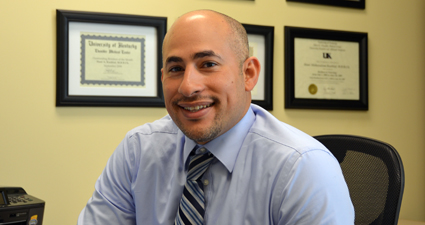
Neuromuscular disorders specialist Hani Kushlaf, MD, in his office at the UC Academic Health Center. Photo by Cindy Starr / Mayfield Clinic
During the nine months since his arrival, Hani Kushlaf, MD, has witnessed significant developments at the Neuromuscular Disorders Program at the University of Cincinnati Neuroscience Institute, one of four institutes of the UC College of Medicine and UC Health. The Neuromuscular Program has increased the number of patients served, has added diagnostic capabilities, and has established a protocol for acquiring and interpreting nerve and muscle biopsies for referred patients and those from other hospital systems.
“We are adding to the neuromuscular medicine services that already exist at UC,” Dr. Kushlaf says. “I am very happy with the progress.”
Neuromuscular diseases, which can be genetic, inflammatory, or autoimmune in origin, are those that affect nerves, muscles, and the neuromuscular junction. They include polyradiculopathies, peripheral nerve diseases, muscular dystrophies, ALS (Lou Gehrig’s disease), motor neuron disorders, and neuromuscular junction disorders (myasthenia gravis and Lambert-Eaton myasthenic syndrome).
Dr. Kushlaf, a UC Health neurologist who sees patients at the UC Physicians’ offices in Clifton and West Chester, came to UCNI with enriched and lengthy training in neuromuscular disorders, having completed three fellowships in muscle disease and peripheral nerve disorders at the Mayo Clinic and an advanced neuromuscular medicine fellowship at Duke University. At UCNI he joined Drs. John Quinlan (Medical Director), Jason Heil, Robert Neel, Joseph Nicolas and Laura Sams.
Two of the new diagnostic technologies now available at UCNI are single-fiber electromyography (SFEMG) and nerve and muscle ultrasound.
SFEMG, which is offered nowhere else in the Greater Cincinnati-Northern Kentucky area, is a selective EMG recording technique that records electrical activity of single muscle fibers. It is primarily used in the diagnosis of patients with ocular myasthenia gravis and difficult-to-diagnose neuromuscular junction disease. “We carefully select patients for the test because we don’t want to do it unless it’s really needed,” Dr. Kushlaf says. “However, it is a very helpful technique. It provides a lot of information in selected patients and can be the only test that allows us to positively diagnose a neuromuscular junction disorder.”
A second diagnostic tool, neuromuscular ultrasound, involves the imaging of nerves and muscles and is performed in conjunction with electrodiagnostic studies. “It is a new technique in the neuromuscular medicine world, and it is helpful as a noninvasive and cost-effective tool to look at focal nerve diseases,” Dr. Kushlaf says.
During the last several months the Neuromuscular Disorders Program has also collaborated with UC Health specialists in surgery and pathology to establish a streamlined method for acquiring nerve and muscle biopsies. “If a physician has a patient who could benefit from a nerve or muscle biopsy, we are happy to offer a consultation,” Dr. Kushlaf says. “We can see the patient in clinic, perform a biopsy and provide a second opinion. Or, we can interpret a biopsy that is sent to us.”
Looking ahead, Dr. Kushlaf, an Assistant Professor of Neurology and Pathology, is hoping to secure two additional components of a program that is moving steadily toward a more national stature: 1) a fellowship for physicians who have completed their general residency training in neurology; and 2) the ability to participate in multi-site clinical trials that study new medications and therapies for patients.
To join the national network of elite institutions that conduct clinical trials, Dr. Kushlaf says, the program first needs to establish a cohort of patients with every neuromuscular disease. “If, for example, we have a number of patients with motor-neuron disease and a number with myasthenia gravis, we would be available as a site to enroll patients in multi-center trials of therapies for those conditions. And we really have arrived at that stage.”
Establishing a critical mass of patients affected by specific neuromuscular diseases is challenging, Dr. Kushlaf says, because many of the diseases in neuromuscular medicine are rare. An institution with 10 patients enrolled in a study, he says, could have the largest number of patients of any study site in the country.
Next on the agenda for Dr. Kushlaf and his colleagues is the annual Muscular Dystrophy Association Camp, which will be held for children June 30 through July 6 at YMCA Camp Campbell Gard in Hamilton, Ohio. The Neuromuscular Disorders Program physicians will be on call 24-7 to provide guidance to on-site medical staff or travel to the camp if needed.
— Cindy Starr


